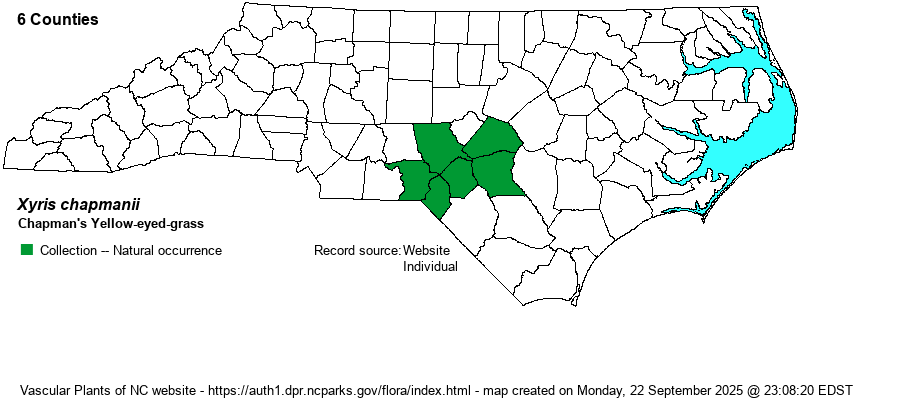| Section 5 » Order Commelinales » Family Xyridaceae |
Show/Hide Synonym
| taxonName | relationship | relatedTaxonName | relatedTaxonRefText | relComments |
|---|
|
| Xyris chapmanii | < | Xyris scabrifolia | Flora of North America (1993b, 1997, 2000, 2002a, 2002b, 2003a, 2004b, 2005, 2006a, 2006b, 2006c, 2007a, 2009, 2010) | | | Xyris chapmanii | < | Xyris scabrifolia | Kartesz (1999) | | | Xyris chapmanii | < | Xyris scabrifolia | Wunderlin & Hansen Flora of Florida (3) | | | Xyris chapmanii | < | Xyris scabrifolia | Kral in Kubitzki (1998b). Key adapted from X, GW, and Z. | | | Source: Weakley's Flora |
|
| Author | E.L. Bridges & Orzell | |
| Distribution | Sandhills only, so far as is known. First discovered in NC during the Fort Bragg inventory in 1992.
Coastal Plain, NC to central SC; central-western GA; northwestern FL to southern MS; eastern TX; recently verified in southern NJ. | |
| Abundance | Rare to uncommon, though the NCNHP database lists 53 records. This is a Significantly Rare species. | |
| Habitat | Wet, usually mucky soils of blackwater streamheads and their ecotones; pitcher-plant seepages. |
| Phenology | Flowering and fruiting late July-August. | |
| Identification | Chapman's Yellow-eyed-grass is one of our medium-sized species, notable for its maroon-colored leaf bases. This color extends well up the lower portion of each leaf. Stems and leaves are generally smooth and without the translucent spicules (little bumps) that are a feature of Harper's Yellow-eyed-grass (X. scabrifolia), and it occurs in wetter microhabitats than that species. | |
| Taxonomic Comments | Some authors (FNA) do not treat X. chapmanii as distinct from X. scabrifolia, but the two are quite distinct here in NC, at least.
Members of Xyris are easy to identify to genus, but can be a challenge to identify species. Careful observation of a few features with a hand-lens is usually sufficient. Close attention must be paid to the flowering head, which is composed of overlapping brown scales. Immediately behind each scale are two brown "lateral sepals"; the margins of these may be feathery or irregularly lacerate (cut into narrow segments) or finely cut into short, comb-like prickles. Lateral sepals may be hidden or a bit longer than each scale. The flowers themselves are usually of little diagnostic value, other than time of flowering -- morning vs. afternoon. Seed size and ornamentation can also be useful characters, but require a dissecting scope to see well. Note also whether leaves and scapes (stems) are twisted and the color of the basal portion. All species have 2-ranked leaves, but in some species the leaves are arranged in a broad, fan-like shape. Finally, note the leaf and stem surface texture -- whether smooth of with little pale bumps. See Godfrey & Wooten (1979) for detailed descriptions and drawings. | |
| Other Common Name(s) | None | |
| State Rank | S3 | |
| Global Rank | G3 | |
| State Status | SR-D | |
| US Status | | |
| USACE-agcp | | |
| USACE-emp | | |

